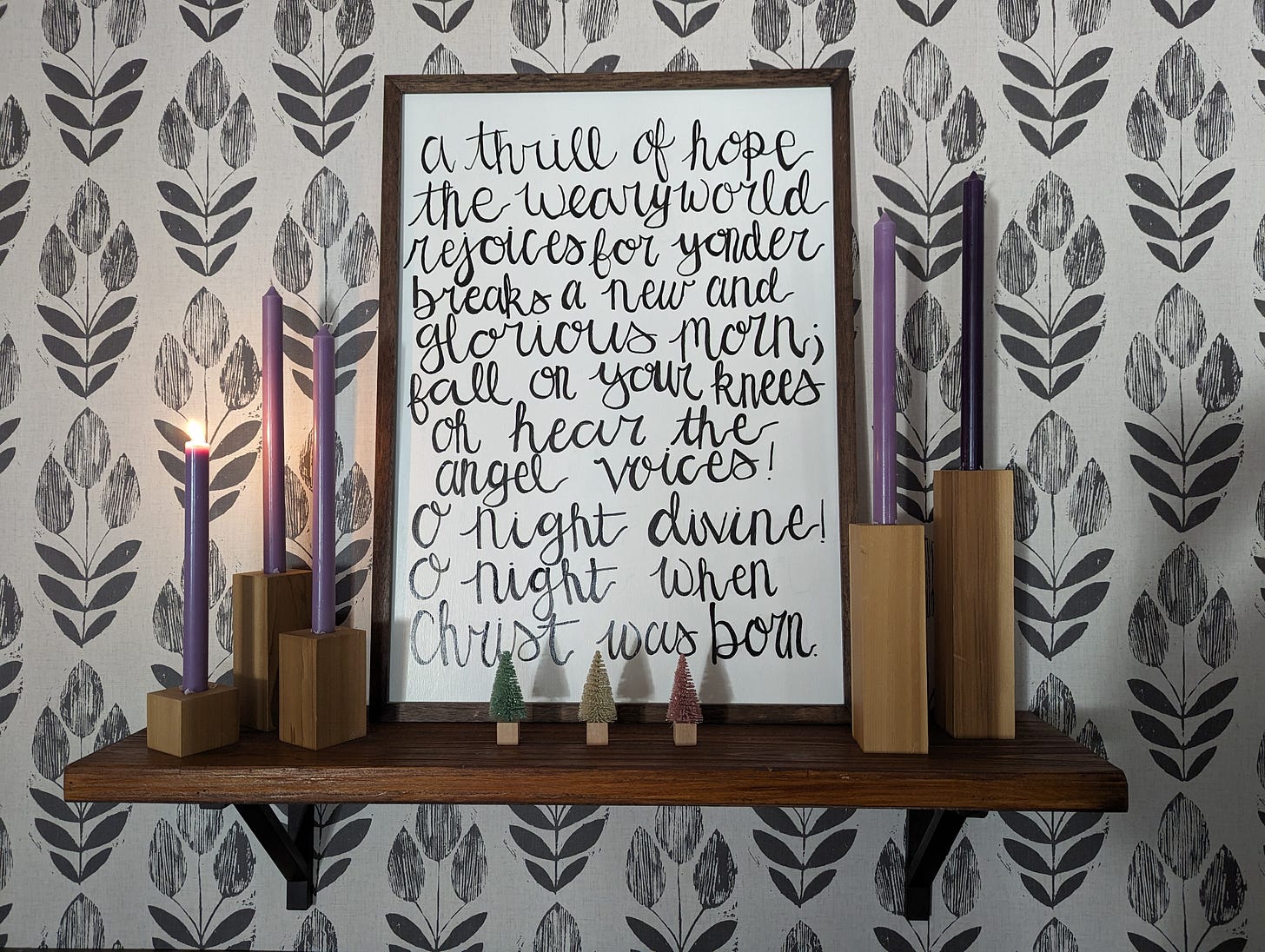“Why do you have a piece of wood on the shelf,” my oldest asked in late November of 2021 as we finalized placement of our new Advent candles. “It’s a placeholder,” I replied, already familiar with my vision for what the shelf would become. But as with any project around here, finalization takes some time. For starters, the wood placeholder would need a few coats of white paint before I could add lines of O Holy Night to complete the art and, as a result, the fruition of the vision.
At first the wood was a visual annoyance standing in the way of the completed project. My head was already moving on to what I wanted it to be, to what it *should* be. But as I sat in the pew of our church on the first Sunday of Advent, the blank woodgrain became a source of inspiration -- a metaphor of hope -- the tension between what was, what is, what is yet to come.
Hope is defined as “a feeling of expectation and desire for a certain thing to happen.” In this analogy, I have the hope — the expectation and desire — for my project to look a certain way. Though it isn’t done today, and probably not tomorrow either, at some point in the near future, the wood will be transformed. And how much is that like the place we occupy in history? We live in the time leading up to Christ’s return. We don’t know when, but we hope in The Promise. It’s not an accident that the Advent candle representing hope is the first to be lit. Hope weaves itself through the season as week after week, other candles — love, joy and peace — add their light. But it’s the flame of hope that burns the longest.
The flame of hope burns the longest.
I was first struck by this reality by a brief quote attributed to April Fiet via Twitter; I liked it and moved on, but it was a concept that quickly took root in the deep places of my heart. It was an idea that sparked my imagination and this piece. Wanting to attribute the concept properly, I went back to locate the tweet. As it turned out, Fiet had published a blog piece on Dec. 2, 2018, called “The Hope Candle Burns the Longest”, and it was beautiful. Her words stirred my spirit. She wrote:
“The thing about hope is that it requires a wait. If we’re already where we want to be, if the journey is already completed, there is nothing to hope for. If we’ve already arrived at the destination, there’s no need to hope. Hope and expectation are things of the journey, not of the arrival.
“As it says in Romans 8:24-25: For in hope we were saved. Now hope that is seen is not hope. For who hopes for what is seen? But if we hope for what we do not see, we wait for it with patience.
“If we’ve arrived – if we’ve realized the goal – there’s no longer any need to hope. Hope will have given way to reality. Promise will have been transformed into what was promised. Hope is the journey of expectation, waiting, and longing. Hope is refusal to give up when the wait drags on. Hope relies on the imagination to continue painting a clear picture of what is to come. Hope pushes us onward even when we’d rather give up.”
Throughout Advent (and our lives), it’s hope that mingles with angst; hope and waiting, (waiting, waiting, waiting) for something new; something complete.
Sometimes, though, we don’t want the tension of holding hope in the shadows. Much like my original impatience to have my art completed in time to take photos for Instagram, how often are we tempted to rush through this season of waiting to celebrate Christmas? How often do we want to bypass the well-worn storyline of the Old Testament that leads to Jesus Christ’s birth rather than be uncomfortable in the anticipation? How often do we push aside the tension of Advent on our way to something “better”?
But what if it’s the tension that helps us recognize the better? What if it’s the incomplete that helps us know the complete? What if it’s the darkness of the shadowland that helps us see the Light? Even a small, low flame feels bright against the dark. And what better time than Advent to renew hope? What better time to remember we’re still Advent people? That if we identify as Christians, we’re still waiting with believers throughout history for The Promise of Jesus Christ and His return?
Yes, we’re still Advent people. We’re still living with the blank piece of wood awaiting its completion. We’re somewhere on the timeline of redemptive history. We’re somewhere between the Advents. And so, we wait. And though we know not the time or the hour, we know He’s coming back. The Promise isn’t complete, but it’s also not forgotten.
Until then, we hope.
This is an expanded version of a blog post first published Nov. 29, 2021 at www.malindajust.com. It was also published Dec. 22, 2021 at The Hillsboro Free Press.
Link:
The Hope Candle Burns the Longest





Malinda, what a profound honor to be included in your beautiful reflection! Thank you!